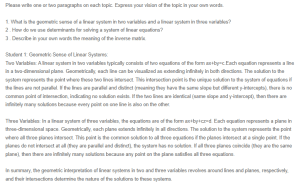Linear Systems – Geometry, Determinants, and Inverse Matrices
Response to Student 1 Post
Hello,
This is a great post. Your explanation of the geometric sense of linear systems in two and three variables is very clear and well-presented. You effectively describe how the solutions to these systems can be visualized as the intersections of lines in a plane (for two variables) or planes in three-dimensional space (for three variables). Your discussion of the different possible scenarios (unique solution, no solution, or infinitely many solutions) based on the relative positions of the lines or planes is also accurate and informative.
Moving on to the use of determinants in solving systems of linear equations, your explanation is concise and to the point. You correctly note that the determinant of the coefficient matrix A, denoted as det(A), can be used to determine the nature of the solutions. If det(A) is non-zero, the system has a unique solution, which can be found using the inverse matrix A^(-1). If det(A) is zero, further investigation is needed to determine if there are infinitely many solutions or no solution at all. Your mention of the practical applications of determinants in fields like engineering and physics underscores their importance.
Finally, your discussion of the meaning of the inverse matrix is also accurate and informative. You correctly define the inverse matrix A^(-1) as the matrix that, when multiplied by the original matrix A, yields the identity matrix I. Your explanation of how the inverse matrix “undoes” the original matrix and its usefulness in solving systems of linear equations and transformations is clear and easy to understand.
Overall, your post demonstrates a solid understanding of the geometric interpretation of linear systems, the use of determinants in solving these systems, and the concept of the inverse matrix. Your explanations are well-organized, clear, and supported by accurate mathematical details.
ORDER A PLAGIARISM-FREE PAPER HERE
We’ll write everything from scratch
Question
Please write one or two paragraphs on each topic. Express your vision of the topic in your own words.
1. What is the geometric sense of a linear system in two variables and a linear system in three variables?
2 . How do we use determinants for solving a system of linear equations?
3 . Describe in your own words the meaning of the inverse matrix.

Geometry, Determinants, and Inverse Matrices
Student 1: Geometric Sense of Linear Systems:
Two Variables: A linear system in two variables typically consists of two equations of the form ax+by=c.Each equation represents a line in a two-dimensional plane. Geometrically, each line can be visualized as extending infinitely in both directions. The solution to the system represents the point where these two lines intersect. This intersection point is the unique solution to the system of equations if the lines are not parallel. If the lines are parallel and distinct (meaning they have the same slope but different y-intercepts), there is no common point of intersection, indicating no solution exists. If the two lines are identical (same slope and y-intercept), then there are infinitely many solutions because every point on one line is also on the other.
Three Variables: In a linear system of three variables, the equations are of the form ax+by+cz=d. Each equation represents a plane in three-dimensional space. Geometrically, each plane extends infinitely in all directions. The solution to the system represents the point where all three planes intersect. This point is the common solution to all three equations if the planes intersect at a single point. If the planes do not intersect at all (they are parallel and distinct), the system has no solution. If all three planes coincide (they are the same plane), then there are infinitely many solutions because any point on the plane satisfies all three equations.
In summary, the geometric interpretation of linear systems in two and three variables revolves around lines and planes, respectively, and their intersections determine the nature of the solutions to these systems.
Using Determinants for Solving Systems of Linear Equations:
Determinants are mathematical tools used to determine the nature of solutions for systems of linear equations. Here’s how they are used:
For a system of linear equations represented in matrix form as Ax=b, where A is the coefficient matrix, x is the vector of unknowns, and b is the constant vector:
The determinant of A, denoted as det(A), is computed.
If det(A)≠0, the system has a unique solution, and it can be found using x=A−1b, where A−1 is the inverse of A.
If det(A)=0, the system can either have infinitely many solutions or no solution. Further examination is required, typically involving row reduction or examining the augmented matrix [A | b], to determine the specific nature of the solutions.
Determinants provide a clear criterion for determining when a system of linear equations has a unique solution, which is crucial in practical applications such as engineering and physics.
Meaning of Inverse Matrix
An inverse matrix is a square matrix that, when multiplied by the original matrix, gives the identity matrix. Here’s a detailed look:
For a square matrix A, if there exists another matrix A−1 such that AA-1 A−1A=I, where I is the identity matrix, then A−1 is called the inverse of A.
The inverse matrix A−1 “undoes” the original matrix A in the sense that multiplying A by A−1 gives the identity matrix, which leaves any vector unchanged when multiplied.
Inverse matrices are particularly useful for solving systems of linear equations, as x=A−1b directly gives the solution vector x. They are also crucial in transformations, where knowing how to reverse a linear transformation (represented by A) is essential.

